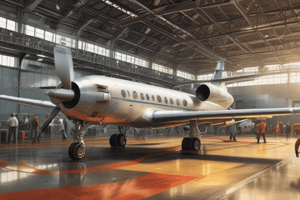Podcast
Questions and Answers
What is the primary purpose of conducting HF training in maintenance organizations?
What is the primary purpose of conducting HF training in maintenance organizations?
What do the Dirty Dozen refer to in the context of human factors training?
What do the Dirty Dozen refer to in the context of human factors training?
What is a direct consequence of complacency between the system and the individual?
What is a direct consequence of complacency between the system and the individual?
Which method is suggested to enhance the safety culture within an organization?
Which method is suggested to enhance the safety culture within an organization?
Signup and view all the answers
How can maintenance organizations effectively reduce maintenance error leaks?
How can maintenance organizations effectively reduce maintenance error leaks?
Signup and view all the answers
Why can't organizations check every individual daily for adherence to safety policies?
Why can't organizations check every individual daily for adherence to safety policies?
Signup and view all the answers
What does RVP stand for in maintaining a safe maintenance environment?
What does RVP stand for in maintaining a safe maintenance environment?
Signup and view all the answers
What is a potential outcome of failing to foster a strong safety culture?
What is a potential outcome of failing to foster a strong safety culture?
Signup and view all the answers
What is the primary objective of aircraft maintenance activities?
What is the primary objective of aircraft maintenance activities?
Signup and view all the answers
What often occurs after reporting maintenance-related incidents?
What often occurs after reporting maintenance-related incidents?
Signup and view all the answers
What is a common result of maintenance errors in aviation?
What is a common result of maintenance errors in aviation?
Signup and view all the answers
What happens to the alert level for maintenance errors over time?
What happens to the alert level for maintenance errors over time?
Signup and view all the answers
What does the article suggest happens to maintenance caution over time?
What does the article suggest happens to maintenance caution over time?
Signup and view all the answers
What contributes to flight delays and fatal accidents according to the article?
What contributes to flight delays and fatal accidents according to the article?
Signup and view all the answers
What role does safety training play in the aviation maintenance environment?
What role does safety training play in the aviation maintenance environment?
Signup and view all the answers
Which of the following factors can contribute to maintenance errors?
Which of the following factors can contribute to maintenance errors?
Signup and view all the answers
Study Notes
Memorial to Rohit Virendra Pandey
- Rohit Virendra Pandey, a Maintenance Technician, tragically died on July 9, 2019, during aircraft maintenance at Kolkata airport, India.
- His initials, RVP, symbolize steps for remembering safety precautions in aircraft maintenance.
Objectives of Aircraft Maintenance
- The main goal of aircraft maintenance is safety and airworthiness.
- Daily routines of maintenance personnel include troubleshooting and repair of aircraft issues before returning to service.
Impact of Maintenance Errors
- Maintenance errors can lead to flight delays, engine shutdowns, injuries, and fatalities.
- Many errors stem from neglecting cautions and warnings in Aircraft Maintenance Manuals (AMM).
Response to Maintenance Incidents
- Organizations implement safety briefings and corrective measures after incidents to mitigate maintenance errors.
- Initial safety awareness may decrease over time, leading to recurring errors.
Importance of Safety Culture
- A strong safety culture in aviation maintenance emphasizes following AMM procedures and recognizing associated warnings.
- Training consists of Human Factors (HF) education, reporting through Safety Management Systems (SMS), and learning from past experiences.
Complexity of Human Behavior
- Unlike aircraft, which cannot self-repair, human performance is influenced by complex behavioral factors.
- Individuals may fail to adhere to safety procedures, increasing the potential for human error, especially in teams.
Preventing Maintenance Errors
- Organizations should focus on reducing errors through HF training and effective communication systems.
- Maintaining awareness of complacency between the system and individuals is crucial to prevent cumulative errors.
Evolving Safety Culture
- Enhancing the safety culture requires involvement at all organizational levels, from management to trainees.
- If safety measures are merely voluntary, they may result in ineffective communication and poor safety outcomes.
Safety Options for Maintenance Organizations
- Exploring various safety options involves assessing the organization's safety culture and individual commitments to safety.
- While organizations can enhance safety culture, they cannot consistently monitor every individual or team.
RVP: Read, Verify, and Practice
- Safety in maintenance environments relies on positive attitudes and commitment.
- Adopting the RVP approach aids individuals and teams in fostering a safer maintenance culture.
Studying That Suits You
Use AI to generate personalized quizzes and flashcards to suit your learning preferences.
Description
This quiz focuses on the essential warnings and cautions related to aircraft maintenance activities, inspired by the memory of Rohit Virendra Pandey. Participants will learn the critical steps to ensure safety and maintain airworthiness during daily operations. It emphasizes the importance of remembering and prioritizing safety protocols in aviation maintenance.




